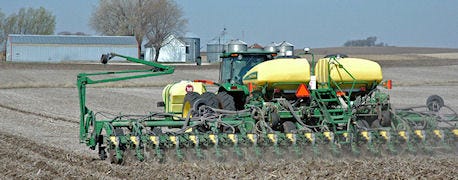May 8, 2013

Although sunny days and a little warmer temperatures are helping push winter behind us, it appears that the 2013 planting season will occur in a more "normal" window, especially compared to last year, says Liz Stahl, University of Minnesota Extension educator – crops, based in the Worthington Regional Extension Office.
"Keep in mind the optimal planting window for southern Minnesota falls from approximately April 21 to May 6," she notes in a recent e-newsletter. "In this window yields were within 1% of the optimal in long-term planting date studies conducted at the Lamberton Southwest Research and Outreach Center. Right now it appears we're on track for a more "normal" planting window."

Planting Window Will Be Normal In Southern Minnesota
The lack of moisture remains a major concern across the region, she says. Precipitation deficits over the past 9-and-a-half months are in excess of 10 inches in some southwestern and south central counties. According to the U.S. Drought monitor, most of the area is in the "Extreme Drought" category, although some parts are in the "Severe Drought" category.
If conditions remain dry, she recommends targeting a two-inch corn planting depth.
"Although there has been discussion about planting at deeper depths when soil conditions are dry, deeper planting depths can result in slower and more variable emergence," she says. "The seedling is also exposed to insects and diseases longer and seedlings are at a greater risk of being exposed to a surface crust because emergence takes longer from deeper depths. Planting more shallow than 1.5 inches is not recommended, as this can result in significant issues with nodal root development, reduced stands and standability of corn, and ultimately reduced yields. We should likely have enough moisture in the top layers of soil for corn seeds to germinate this spring. More moisture will be needed as seedlings develop, however, as soil moisture conditions throughout the rooting zone are currently near all-time lows."
Every decision that you make influences the size and scope for corn yields. From the corn hybrid you select to the seeding rate and row width you choose. Download our FREE report over Maximizing Your Corn Yield.
Regarding corn planting populations if conditions remain dry, she points to research conducted by Jeff Coulter, U-M corn agronomist. That research demonstrated that yields and profitability are typically optimized at stands of 32,000 to 34,000 plants per acre.
"Adjusting for germination percent, this would typically translate to a planting population of approximately 34,000 to 36,000 seeds per acre," she says. "If you are considering starting with a lower population as a tactic to reduce the risk of yield loss if drought conditions persist, consider that you may likely just ensure a loss in yield potential if adequate moisture is received during the season. We can't predict what the growing season will be like, but starting with stands in the range of 32,000 to 34,000 will help lay the foundation for optimal yield potential and maximum profitability."
For more information as you prepare for the 2013 planting season, check out additional U-M Extension resources available online at www.extension.umn.edu
Click on "Agriculture" and select options such as corn, soybean, small grains, forages or nutrient management websites.
Source: U-M Extension
You May Also Like




